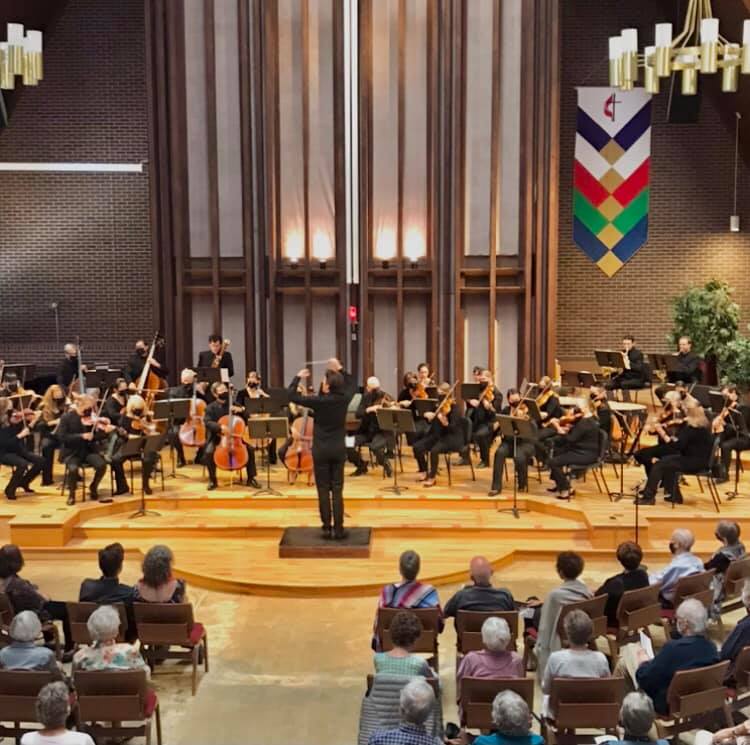Abbreviated concerts featured careful COVID protocols, no intermissions
By Peter Alexander Oct. 3 at 11:30 p.m.
For a short time this past weekend, you could have believed that concert life in Longmont and Boulder had returned to normal.
Of course, no one knows what tomorrow will bring. But both the Longmont Symphony and the Boulder Philharmonic presented their first in-person concerts in nearly two years, and sitting in the audience hearing live music was a welcome return to near-normal.

Both concerts—the LSO at Vance Brand Auditorium at 7 p.m. Saturday, and the Boulder Phil at Mountain View Methodist Church at 4 p.m. Sunday—had restrictions that for now we might consider the “new normal.” In both cases, patrons were met outside by orchestra representatives checking proof of vaccination and ID, masks were required at all times, and seating was limited to less than full capacity of the respective venues. Conductors and orchestral string players wore masks for the performances as well. Both concerts were presented without intermission, so that the audience did not have the chance to mix and mingle.
Both conductors, Elliot Moore with the LSO and Michael Butterman with the Boulder Phil, commented on how good it felt to be back, and both were greeted with enthusiasm. I would add that both concerts received standing ovations, but that has long since become normal, so it is not really anything new.
The Longmont Symphony began with a rousing performance of Brahms’s Academic Festival Overture. In his introduction, Moore noted that in spite of its name, the overture is not really academic in nature, because it is actually based on student drinking songs of Brahms’s era. As Moore intended, it started the post-pandemic musical scene with infectious energy.
Brahms was followed by Mozart’s Piano Concerto in A major, K414, featuring soloist Hsing-ay Hsu. She introduced the concerto with heartfelt remarks about the opportunity to perform again before an audience, and played with solid confidence and sensitivity. The concert of orchestral repertory standards ended with Robert Schumann’s Symphony No. 4 in D minor. Any minor lapses of intonation or ensemble were easily forgiven for musicians who had not played together for so many months. Shouts of “Bravo” were heard through the standing ovation.

Butterman chose much less standard works for the Boulder Phil’s return to the stage. Two works by Haydn were featured, none of them among the composer’s better known symphonies or concertos. In fact, the concert started at the very beginning, one could say, with Haydn’s Symphony No. 1 of 1759. A three-movement work of about 12 minutes in length, it has the tunefulness and energy, if not the sophistication, of Haydn’s larger late Symphonies. “If you liked that piece,” Butterman quipped, “there are 100 more like it!” (For the record, current research has identified 108 symphonies by Haydn.)
The symphony was paired with Haydn’s Sinfonia Concertante written for London in 1792, a larger and more mature work that features violin, oboe, cello and bassoon soloists with orchestra. The principal players from the orchestra played the solo parts with elan and polish. Using modern instruments, and heard in a church that has only a cement floor due to ongoing renovations, the orchestral sound struck me as a little on the thick side, not as transparent as Haydn would have expected.
Butterman’s final work for the program is one that he particularly loves, the Petite symphonie concertante by the 20th-century Swiss composer Frank Martin. It was a treat to hear this genuine rarity live in concert. It is scored for a double string orchestra with harpsichord, piano and harp soloists, creating an utterly unique sound world. Although written using 12-tone techniques, the music is often consonant, always enjoyable, and unlike any other piece I know.
Butterman led the orchestra with obvious relish. The size and full-bodied sound of the Phil’s strings was ideal for a 20th-century work. In his analytical introduction to the score, Butterman said that he hoped that the audience would enjoy the Petite symphonie concertante as much as he does. I can’t speak for the rest of the audience, but hearing a committed live performance of an intriguing rarity was the weekend’s highlight for me.
Like both audiences, I was thrilled to hear live music again, and to be back in the hall with musicians who love what they are doing. More, please!
NOTE: Minor typos and editing errors corrected Monday, 10/4.
